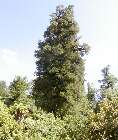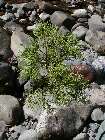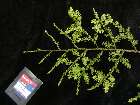Dacrycarpus dacrydioides
(A. Richard) de Laubenfels 1969
Common names
Kahikatea (Maori), white pine.
Taxonomic notes
Synonymy (Farjon 1998):
Podocarpus dacrydioides A. Richard 1832,
Dacrydium excelsum D. Don 1828,
Podocarpus thujoides R. Br. ex G. Benn. 1838,
Nageia dacrydioides (A. Richard) F. Mueller 1876,
Nageia excelsa (D. Don) Kuntze 1891,
Podocarpus excelsus (D. Don) Druce 1917.
Although the species was described by Solander after Captain Cook's first expedition in 1769-1770, Solander died suddenly and his account was never published; the first valid publication was not until 1832, when A. Richard described it on the basis of material collected by P.A. Lesson in 1827 near what is now called Astrolabe Bay (Salmon 1996).
Description
Tree to 50 m or more in height and 150 cm dbh, often fluted and buttressed at base, the trunk clear of branches for a considerable height. Submature trees have a conical crown. Bark dark grey, covered irregularly with small protuberances ca. 1-2 mm across and 1-2 mm high, scaling off in large, ovoid flakes. Branchlets slender and drooping. The kahikatea seedling bears juvenile foliage until 1-2 m high, when semi-adult or adult foliage may appear. The juvenile, semi-adult and adult foliage stages often occur together on the same tree. Juvenile leaves are subdistichous, subpatent, narrow-linear, subfalcate, acuminate, decurrent, 3-7 × 0.5-1 mm. Adult leaves are 1-2 mm long, imbricate, appressed, keeled, subtrigonous, lanceolate-subulate to acuminate, with broader base. Pollen cones are terminal, up to 1 cm long, with bisporangiate sporophylls, apiculus acute. Seeds are solitary, terminal on short branchlets, upper 2-3 leaves forming a distinct receptacle, red, swollen and succulent when in fruit. A male tree glows a faint orange when the cones are mature, a female red when its berry-like receptacles are ripe. Seeds are 4-5 mm long, broadly ovoid, black, nutlike (Allan 1961, Salmon 1996, Metcalf 2002). See García Esteban et al. (2004) for a detailed characterization of the wood anatomy.
Most of the year, kahikatea does not bear recognizable reproductive structures, and in its native forest it is commonly so tall that foliage characters are of little use in identification. The bark characters and tree form are thus the principal aid in field identification. Also, it sheds foliage and branchlets fairly constantly, so fallen foliage is often available to confirm identification. The bark of young trees is relatively undistinctive, but that of mature trees is not readily confused with that of any other native New Zealand conifer except miro (Pectinopitys ferruginoides), which usually lacks buttressing and has highly distinctive foliage.
Distribution and Ecology
New Zealand, in lowland and montane forests (0-600 m elevation) throughout the North, South and Stewart Islands. Within its range, mean annual temperature is 11.0°C, with an average minimum in the coldest month of 1.6°C, and a mean annual precipitation of 2913 mm (Biffin et al. 2011, Table S5).
Although formerly one of the commonest of native trees, timber milling and land clearance have greatly reduced its habitats. Kahikatea dominates two main landforms: the fertile, silty, free-draining floodplains and low terraces of rivers, and the wet margins of the lowland swamps and bogs (generally referred to by the Maori name pakihi) of the West Coast of the South Island. Small groups of young trees are not infrequently seen on some farmlands (Cubitt and Molloy 1994, Metcalf 2002), but the native old growth forests support an extraordinarily complex and diverse epiphytic flora (Dickinson et al. 1993).
Zone 9 (cold hardiness limit between -6.6°C and -1.1°C) (Bannister and Neuner 2001).
"The successional ecology of kahikatea forests is dependent on frugivorous birds dispersing seed of both pioneer shrub species and kahikatea itself. ... Different bird species [prefer] different-aged stands ... The diversity of [native] birds ... was positively correlated with increasing structural complexity of the vegetation. Bird abundance changed markedly with season. Frugivorous birds were extremely common in the fruiting season of kahikatea" (Robertson and Hackwell 1995).
Beveridge (1964) describes the dispersal and fate of seeds from New Zealand (Pureora Forest) podocarps. He reported three mast years for kahikatea during a 10-year period, with one more year of reduced but significant seed production. A large mature kahikatea yielded 300 pounds (136 kg) of sound seed, representing 4.5 million seeds. These ripened in May. Most such seeds germinate in the following late spring and summer. Like nearly all podocarps, the kahikatea is dispersed by birds that eat the seeds, digest the fleshy receptacle, and excrete the seed. Beveridge found that most podocarp seeds were dispersed by New Zealand pigeons
(Hemiphaga novaeseelandiae), tuis (Prosthemadera novaeseelandiae) and bellbirds (Anthornis melanura). Some smaller birds, primarily non-native species (Indian mynas, Acridotheres tristis; starlings, Sturnus vulgaris; and sparrows, Passer domesticus), eat the receptacle piecemeal and drop the seed, and thus do not act as agents of dispersal. Although podocarp seeds are very commonly excreted by birds perching in trees, sampling cut-over areas near intact podocarp forest found kahikatea seedlings up to 100 m from the forest edge, indicating that birds do effectively disperse seed into open areas. Beveridge also detailed the destruction of podocarp seed. Much seed is apparently destroyed in the tree's crown by animal (insect, bird or rodent) activity. Black rats (Rattus rattus), an abundant invasive species, show a hearty appetite for podocarp seeds, though taking other species in preference to kahikatea. These results suggest that non-native species may significantly impair kahikatea seed dispersal, but the possible ecological consequences of this are not discussed by Beveridge (1964).
Remarkable Specimens
This is the largest species in the genus. The largest reported tree is 309 cm dbh and 31.8 m tall, on private property in Morrisons Bush, NZ (New Zealand Tree Register 2019.12.21). The largest public-access specimen, and almost certainly the largest specimen in terms of biomass or wood volume, is in the Lake Brunner Reserve near Kumara; discovered on 2019.12.18, it is 251 cm diameter at a height of 2 m (dbh measurement not taken due to large buttress) and 49.2 m tall (details and photos at the New Zealand Tree Register 2019.12.21).
The tallest known native tree in New Zealand is a kahikatea in the Pirongia Forest Reserve, 62.7 m tall when measured in 1996/7 by a Department of Conservation ranger (emails from Sonia Frimmel, 2012.05.22; and Bruce Postill, DoC, 2012.06.18). There are unconfirmed reports floating about the Web (as of mid-2012) of a 66 or 67 m tree, also in Pirongia. Older tall tree reports include one 229.3 cm dbh and 56.4 m tall, on private land near Matirangi Forest in the Taranaki region (R. Van Pelt email 2009.04.14). Another very tall tree, 220 cm dbh and 55.1 m tall, was measured in the Pirongia Forest Reserve (R. Van Pelt email 2003.01.27).
The oldest reported tree was 716 years for a tree at the Paengaroa Scenic Reserve, near Taihape on the North Island (Burns et al. 1999). This was based on a ring-counted core with extrapolation to the geometric center of the tree, which is probably a reasonably accurate approach for this species. The tree was in an old-growth mixed forest in an area with a relatively dry, cool forest, that also yielded a 1,358-year-old specimen of Prumnopitys taxifolia. As best I know, the tree is still alive.
Ethnobotany
See Conifers of New Zealand for a review of the historic role of forests in native and European cultures of New Zealand. As with most of New Zealand's native podocarps, the kahikatea forests were severely depleted by historical logging. The devastation of this species was particularly severe because it grew best on wet lowlands ideally suited for agriculture. The story is well told by Envirohistorynz (2010).
The Maori say that the kahikatea is the child of Tane and Hine waoriki, or of Tane and Kuraki. They used a decoction of the leaves to treat urinary complaints. The wood was used to make weapons and canoes, the burned soot of heartwood for tattooing, the bark for torches, and the gum for chewing gum (Interpretive sign at Otorohanga Kiwi House, 2003).
The species has some use in dendrochronological research. The earliest work is recounted by Bell and Bell (1958), who only note that the species is promising. Dunwoodie (1979) again considered the species, but did nothing with it. It was finally put to use in a study tracking long-term changes in metals contamination due to settlement and urbanization in the vicinity of Christchurch (Stewart et al. 1991).
Observations
Some of the finest examples of native kahikatea forest can be found in the Whirinaki and Pureora forests. Based on my experience, I particularly recommend the Hunter's Track and the Pouakani Reserve in Pureora as having very large trees, and the track up the Whirinaki River from Minginui as having a dense, lush forest on river terraces, with many trees more than 200 cm in diameter. The Ohinetake Tall Trees grove near Owhango provides a splendid example of a floodplain kahikatea forest. In general, it will not be difficult to find this tree in New Zealand; it is one of the commonest of the native podocarps, although it is uncommon in some native forests (such as around Mt. Ruapehu, and in areas dominated by the beech, Nothofagus). Conversely, I have rarely seen a specimen outside New Zealand. Although this is a lovely and distinctive tree at maturity, it tends to be scrawny as a sapling, and thus is not a popular ornamental.
Remarks
The epithet indicates a similarity to Dacrydium.
This species has been described from early Miocene (about 20 million years ago) sediments in southern New Zealand (Pole 2007).
Kahikatea entered the science of Botany on the day that Joseph Banks sailed up the Waihou River late in 1769. He remarked "The banks were completely clothed with the finest timber my eyes ever beheld, of a tree we had before seen, but only at a distance, in Poverty Bay and Hawke's Bay. Thick woods of it were everywhere upon the banks, every tree as straight as a pine, and of immense size, and the higher we went the more numerous they were." (Salmon 1996).
The following remarks are taken from George Seddons' review of Geoff Parks' book, "Nga Uruora" (Williams 1999).
"These trees are Gondwanan, not pines, but ancient as the pines, and like them, gymnosperms. ...
"Geoff Park may take the reader's familiarity with New Zealand botany for granted, along with much else, but he does build up a powerful sense of the tree as a living presence, through his own words and those of others. Cook's party mentioned one 'that girthed 19 feet 8 inches, 6 feet above the ground ... I found its length from the root to the first branch to be 89 feet.' Mature trees may reach heights greater than 50 metres. They were very tall by European standards, tall even by Australian standards, with boles that are massive by any standards, further pushed out by plank buttresses at the base, as is typical of swamp trees. ... [T]races of kahikatea pollen and leaves have been identified by palynologists and paleobotanists in rocks from the Jurassic, some 160-180-million years ago. Park says, 'Kahikatea persists from an old, swampy, worn-down, tropical archipelago, utterly different from the cool, young, mountainous New Zealand of today. You can find it in the hills, but it only prospers in the swamps, and it would vanish without them.' ...
"The small fruit (koroi) are superabundant and highly nutritious. The birds ate them and flocked for miles to do so. 'Go into a lowland kahikatea forest in autumn', says Park, 'when its koroi are ripening, lie under the towering trees listening to the cacophony of birds and the constant patter of the inedible hits hitting the leaves around you, and you'll know what 'the groves of life' mean.' The birds ate the koroi: the Maori ate the koroi and the birds. In 1841, in autumn, the botanist James Bidwill, for whom one of our araucaria (Araucaria bidwillii) is named, saw the 'enormous kahikatea loaded with their beautiful scarlet and black fruit ... which ... formed a great part of the food of the natives during the season.' He counted 60 large baskets of them in one village, although their gathering must have been hazardous. There is a Maori epigram to the point: 'He toa piki rakau kahikatea, he kai na te pakiaka' : 'The kahikatea climber is food for the roots.'
"Now they are all gone from the lowlands of the North Island, except for a few pocket remnants; there is a pocket in the South Island in the midst of suburban Christchurch, Riccarton Bush, there because of just one family who loved it; still a wonder and a sanctuary from its mind-numbing context, but the cold wet West Coast of the South Island is their only major refuge, one in which they do not reach the grandeur of those of Hauraki. Cook and other naval men thought they would be a great naval resource for masts and spars, but they proved not to be durable, and most of the warm forests were felled for butter boxes when the refrigerated export of butter became feasible from Australia and New Zealand in the 1880s."
Citations
Allan, H. H. 1961. Flora of New Zealand. Volume I, Indigenous Tracheophyta. Wellington: R.E. Owen Government Printer.
Bell, V. and R. E. Bell. 1958. Dendrochronological studies in New Zealand. Tree-Ring Bulletin 22:7-11.
Beveridge, A. E. 1964. Dispersal and destruction of seed in central North Island podocarp forests. Proceedings of the New Zealand Ecological Society 11:48-56.
Burns, B. R., M. C. Smale, and M. F. Merrett. 1999. Dynamics of kahikatea forest remnants in middle North Island: implications for threatened and local plants. Science for Conservation 113. Wellington, NZ: Department of Conservation. 23 pp. Available: www.doc.govt.nz/documents/science-and-technical/Sfc113.pdf, accessed 2014.08.25.
Dunwiddie, P. W. 1979. Dendrochronological studies of indigenous New Zealand trees. New Zealand Journal of Botany 17: 251-266.
Envirohistorynz. 2010. The slaying of our kahikatea forests. https://envirohistorynz.com/2010/10/31/the-slewing-of-our-kahikatea-forests-how-jurassic-giants-became-butter-boxes/, accessed 2019.02.28.
Stewart, C., D. A. Norton, and J. E. Fergusson. 1991. Historical monitoring of heavy metals in kahikatea ring wood in Christchurch, New Zealand. Science of the Total Environment 105: 171-190.
Williams, Robyn. 1999. O Brave New World. http://www.abc.net.au/rn/science/ockham/stories/s373.htm, accessed 2001.06.09, now defunct.
See also
Gymnosperms of New Zealand.
Nature and Company Ltd. 1999. New Zealand's native podocarp broadlef forests. www.natureandco.co.nz/land_and_wildlife/flora/forest/podoc-top.php3, accessed 2001.06.09, now defunct.
The New Zealand Plant Conservation Network, accessed 2010.11.22.
Project Kahikatea, http://www.projectkahikatea.net.nz/index.html, accessed 2012.06.16, now defunct, was dedicated to the documentation and preservation of the kahikatea.
Webb, C.J. and M.J.A. Simpson. 2001. Seeds of New Zealand Gymnosperms & Dicotyledons. Auckland: Manuka Press.














